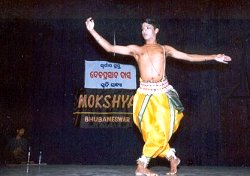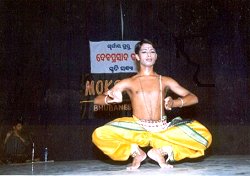
|
 |

|
 |
Transforming the soul through dance by Rahul Acharya, Bhubaneswar e-mail: rahul_acharya@rediffmail.com August 19, 2004 The simplest definition of dance is a rhythmical skipping and stepping, with regular turnings and movements of the limbs and body, usually to the accompaniment of music. Every living being is instinctively engaged in rhythmic movements to express its characters. For example certain birds and animals have their dances of courtship. The instinctive nature of dance can be seen in the very young, for children, even babies, move quite naturally to the rhythmic impulses they feel within themselves. The intelligent human beings, who have been empowered to think, found that the rhythmic movements had a powerful effect on the mind and produced a supernatural feeling. From this they developed the idea of magic. When they repeated their dance, they found that they could recreate the feeling of magic power. Dance has inculcated the sense of rhythm in all living beings. The earth moves round the sun in a rhythm, the wind blows in a rhythm, the rain showers in a rhythm, every microscopic organism also has a rhythm. In this universe everything is based on rhythm. Without rhythm time has no definition. Mathematically, rhythm is nothing but the division of time. Therefore dance is the rhythm of life and living beings, i.e. dance or impulsive movements suggest the presence of life in an object. For ages dance has been considered as an art. It is probably the easiest of all the arts. Every person has an instinctive sense of dance. All the same it is very difficult to provide a correct definition for dance because its antiquity, vastness and multiple facets make it impossible to make a total conclusive statement. In India, the tradition of dance is deeply rooted in religion and the dancer who undergoes deep mystical experiences, leading to a state of trance, is considered to be a perfect embodiment of what the treatises on Indian dance suggest. Indian culture is based on spiritualism and as dance forms an integral part of Indian culture, it involves spiritual experiences thereby transforming oneself to the seventh heaven. These experiences include horripilations, incessant crying, internal vibrations etc, which suggest complete involvement of the dancer. The message conveyed through such experiences is that every object, whether animate or inanimate, is considered to be a fragment of the Supreme Being and when both the souls merge, the former attains, what in the Hindu terminology is Moksha or salvation. Hence dance is a logical way to attain salvation. The logic herein involved is that while dancing, the dancer gets transformed from the material world to a deeply spiritual world thereby communicating with celestial beings. It is exactly the same in chemical sciences where atoms migrate from the ground state to an excited state to achieve conjugation. Indian dance deals with gods and thus the dancer feels one with the gods, undergoing this process of transformation. This transformation occurs very slowly but spontaneously. As the dancer enters the platform of dance, with slow pulsating movements, the enchanting music accompanying it, shuts all communions with the outside world, thereby creating a different world altogether. Now the dancer enters a slow and smooth passage through the road to heaven, a state of bliss. On the way the dancer undergoes several mystical experiences. During this time one observes divine effulgence in the body of the dancer when the latter is undergoing such a process of transformation. Finally the dancer attains Samadhi i.e. a state in which the body metabolism stops completely but the person is still alive. Great Indian mystics have mentioned about this stage in which the soul becomes one with God. During the dance, the dancer prays to the divine spirit with the following words: "Oh Lord! From the unreal lead me to the real, From darkness lead me to light, from death lead me to immortality." This is that dance, its deepest significance is felt when it is realized that it takes place within the heart and the self. Everywhere is God. Using this context, there is complete internalization of the subject and the dancer, quite oblivious of the external surrounding, becomes one with the dance. This is the dance of enlightenment. During this whole process of transformation that one undergoes, the dancer is changed as a person too. One becomes more disciplined, because such experiences require a long and thorough preparation with complete dedication. The person starts observing things differently. In everything one feels the presence of supernatural vibrations and sees a divine brightness everywhere. No matter what one does, the dancer is always in a state of ecstasy. This is a stage of Bhakti or complete surrender to the Supreme Being. Wherever the mind goes, there it experiences Samadhi, for it does not find an object of enjoyment. God is filling every speck of space. The whole world is clothed with the glory of god. The saint and the sinner, the virtuous and the vicious, the good and the bad, the man and the animal, all are forms of god. There is no question of the mind dealing with them in an undivine way. Here the mind too undergoes a gradual transformational process. The mind experiences Samadhi. The mind has consciousness. But it has no object. This is the condition of Samadhi that is thoughtless consciousness and objectless knowledge. Slowly objective consciousness dies when the presence of god is felt everywhere. The sense objects are transformed into the glory of divinity. Such is the transformational power of dance that it changes an ordinary mortal into a self-attained entity. Author's note: I am greatly indebted to Prof. Dr. D.P Dash, Xavier Institute of Management, Bhubaneswar for his wonderful ideas about how to write an article. I have also been greatly inspired by "The Tao of Physics" by Fritjof Capra.   Rahul Acharya has been learning Odissi under the tutelage of Guru Durga Charan Ranbir since the age of 4. He is an empanelled artist of Indian Council for Cultural Relations (ICCR) since March 2003 and is an honorary member of the Sacred Dance Guild, USA. He is doing research in Jagannath Culture and is a regular contributor to narthaki.com |